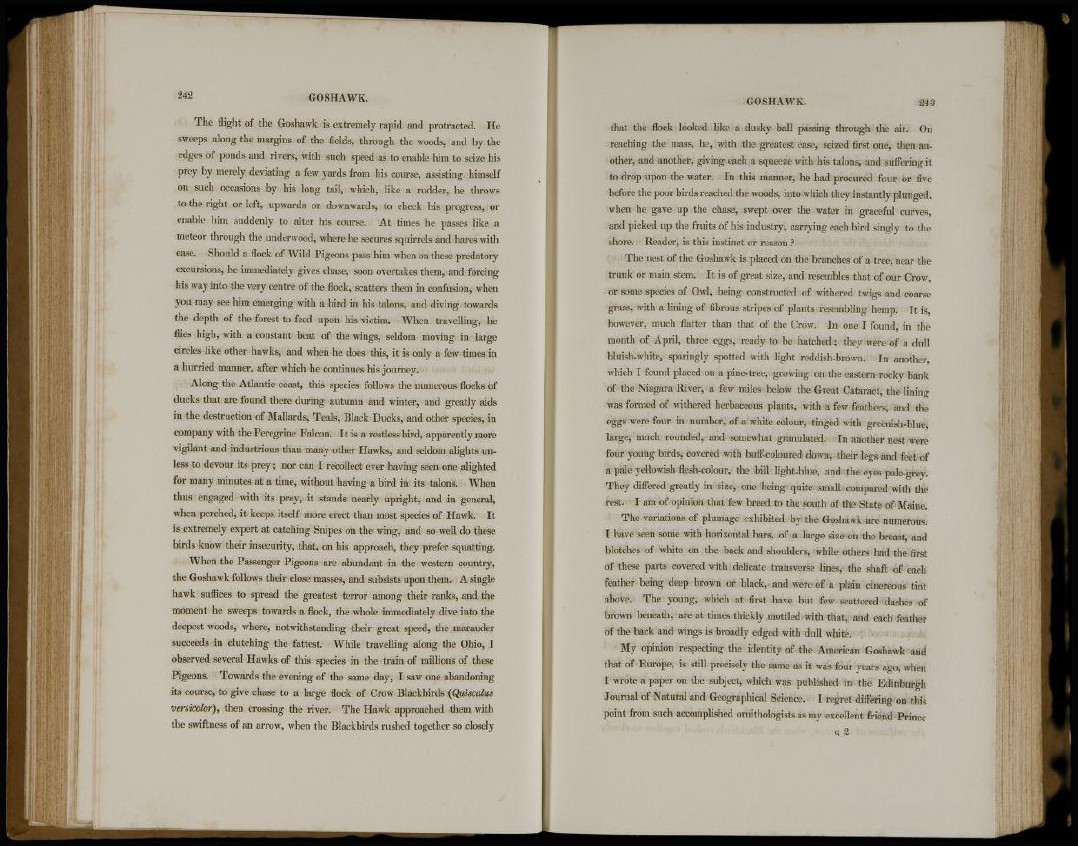
242 GOSHAWK.
The flight of the Goshawk is extremely rapid and protracted. He
sweeps along the margins of the fields, through the woods, and by the
edges of ponds and rivers, with such speed as to enable him to seize his
prey by merely deviating a few yards from his course, assisting himself
on such occasions by his long tail, which, like a rudder, he throws
to the right or left, upwards or downwards, to check his progress, or
enable him suddenly to alter his course. At times he passes like a
meteor through the underwood, where he secures squirrels and hares with
ease. Should a flock of Wild Pigeons pass him when on these predatory
excursions, he immediately gives chase, soon overtakes them, and forcing
his way into the very centre of the flock, scatters them in confusion, when
you may see him emerging with a bird in his talons, and diving towards
the depth of the forest to feed upon his victim. When travelling, he
flies high, with a constant beat of the wings, seldom moving in large
circles like other hawks, and when he does this, it is only a few times in
a hurried manner, after which he continues his journey.
Along the Atlantic coast, this species follows the numerous flocks of
ducks that are found there during autumn and winter, and greatly aids
in the destruction of Mallards, Teals, Black Ducks, and other species, in
company with the Peregrine Falcon. It is a restless bird, apparently more
vigilant and industrious than many other Hawks, and seldom alights unless
to devour its prey; nor can I recollect ever having seen one alighted
for many minutes at a time, without having a bird in its talons. When
thus engaged with its prey, it stands nearly upright, and in general,
when perched, it keeps itself more erect than most species of Hawk. It
is extremely expert at catching Snipes on the wing, and so well do these
birds know their insecurity, that, on his approach, they prefer squatting.
When the Passenger Pigeons are abundant in the western country,
the Goshawk follows their close masses, and subsists upon them. A single
hawk suffices to spread the greatest terror among their ranks, and the
moment he sweeps towards a flock, the whole immediately dive into the
deepest woods, where, notwithstanding their great speed, the marauder
succeeds in clutching the fattest. While travelling along the Ohio, I
observed several Hawks of this species in the train of millions of these
Pigeons. Towards the evening of the same day, I saw one abandoning
its course, to give chase to a large flock of Crow Blackbirds (Quiscalus
versicolor), then crossing the river. The Hawk approached them with
the swiftness of an arrow, when the Blackbirds rushed together so closely
GOSHAWK.
that the flock looked like a dusky ball passing through the air. On
reaching the mass, he, with the greatest ease, seized first one, then another,
and another, giving each a squeeze with his talons, and suffering it
to drop upon the water. In this manner, he had procured four or five
before the poor birds reached the woods, into which they instantly plunged,
when he gave up the chase, swept over the water in graceful curves,
and picked up the fruits of his industry, carrying each bird singly to the
shore. Reader, is this instinct or reason ?
The nest of the Goshawk is placed on the branches of a tree, near the
trunk or main stem. It is of great size, and resembles that of our Crow,
or some species of Owl, being constructed of withered twigs and coarse
grass, with a lining of fibrous stripes of plants resembling hemp. It is,
however, much flatter than that of the Crow. In one I found, in the
month of April, three eggs, ready to be hatched ; they were of a dull
bluish-white, sparingly spotted with light reddish-brown. In another,
which I found placed on a pine-tree, growing on the eastern rocky bank
of the Niagara River, a few miles below the Great Cataract, the lining
was formed of withered herbaceous plants, with a few feathers, and the
eggs were four in number, of a white colour, tinged with greenish-blue,
large, much rounded, and somewhat granulated. In another nest were
four young birds, covered with buff-coloured down, their legs and feet of
a pale yellowish flesh-colour, the bill light-blue, and the eyes pale-grey.
They differed greatly in size, one being quite small compared with the
rest. I am of opinion that few breed to the south of the State of Maine.
The variations of plumage exhibited by the Goshawk are numerous.
I have seen some with horizontal bars, of a large size on the breast, and
blotches of white on the back and shoulders, while others had the first
of these parts covered with delicate transverse lines, the shaft of each
feather being deep brown or black, and were of a plain cinereous tint
above. The young, which at first have but few scattered dashes of
brown beneath, are at times thickly mottled with that, and each feather
of the back and wings is broadly edged with dull white.
My opinion respecting the identity of the American Goshawk and
that of Europe, is still precisely the same as it was four years ago, when
I wrote a paper on the subject, which was published in the Edinburgh
Journal of Natural and Geographical Science. I regret differing on this
point from such accomplished ornithologists as my excellent friend Prince
ft 2